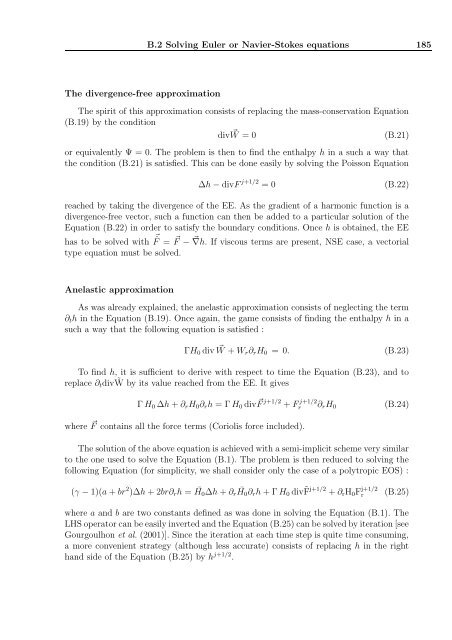Ecole doctorale de Physique de la région Parisienne (ED107)
Ecole doctorale de Physique de la région Parisienne (ED107)
Ecole doctorale de Physique de la région Parisienne (ED107)
Create successful ePaper yourself
Turn your PDF publications into a flip-book with our unique Google optimized e-Paper software.
The divergence-free approximation<br />
B.2 Solving Euler or Navier-Stokes equations 185<br />
The spirit of this approximation consists of rep<strong>la</strong>cing the mass-conservation Equation<br />
(B.19) by the condition<br />
div W = 0 (B.21)<br />
or equivalently Ψ = 0. The problem is then to find the enthalpy h in a such a way that<br />
the condition (B.21) is satisfied. This can be done easily by solving the Poisson Equation<br />
∆h − divF j+1/2 = 0 (B.22)<br />
reached by taking the divergence of the EE. As the gradient of a harmonic function is a<br />
divergence-free vector, such a function can then be ad<strong>de</strong>d to a particu<strong>la</strong>r solution of the<br />
Equation (B.22) in or<strong>de</strong>r to satisfy the boundary conditions. Once h is obtained, the EE<br />
has to be solved with ˆ F = F − ∇h. If viscous terms are present, NSE case, a vectorial<br />
type equation must be solved.<br />
Ane<strong>la</strong>stic approximation<br />
As was already exp<strong>la</strong>ined, the ane<strong>la</strong>stic approximation consists of neglecting the term<br />
∂th in the Equation (B.19). Once again, the game consists of finding the enthalpy h in a<br />
such a way that the following equation is satisfied :<br />
ΓH0 div W + Wr∂rH0 = 0. (B.23)<br />
To find h, it is sufficient to <strong>de</strong>rive with respect to time the Equation (B.23), and to<br />
rep<strong>la</strong>ce ∂tdiv ˜ W by its value reached from the EE. It gives<br />
Γ H0 ∆h + ∂rH0∂rh = Γ H0 div F j+1/2 + F j+1/2<br />
r ∂rH0 (B.24)<br />
where F contains all the force terms (Coriolis force inclu<strong>de</strong>d).<br />
The solution of the above equation is achieved with a semi-implicit scheme very simi<strong>la</strong>r<br />
to the one used to solve the Equation (B.1). The problem is then reduced to solving the<br />
following Equation (for simplicity, we shall consi<strong>de</strong>r only the case of a polytropic EOS) :<br />
(γ − 1)(a + br 2 )∆h + 2br∂rh = ¯ H0∆h + ∂r ¯ H0∂rh + Γ H0 div ˜ F j+1/2 + ∂rH0F j+1/2<br />
r<br />
(B.25)<br />
where a and b are two constants <strong>de</strong>fined as was done in solving the Equation (B.1). The<br />
LHS operator can be easily inverted and the Equation (B.25) can be solved by iteration [see<br />
Gourgoulhon et al. (2001)]. Since the iteration at each time step is quite time consuming,<br />
a more convenient strategy (although less accurate) consists of rep<strong>la</strong>cing h in the right<br />
hand si<strong>de</strong> of the Equation (B.25) by h j+1/2 .
















